TB Contact Tracing and Epidemiology
VerifiedAdded on 2020/10/23
|10
|3313
|302
AI Summary
The assignment discusses the significance of contact tracing in epidemiology, particularly in the context of tuberculosis. It presents a scenario where an individual is identified as having TB and explores how this information can be used to inform public health decisions. The assignment also touches on the differences between contact tracing guidelines for Northern Territory and Victoria in Australia.
Contribute Materials
Your contribution can guide someone’s learning journey. Share your
documents today.
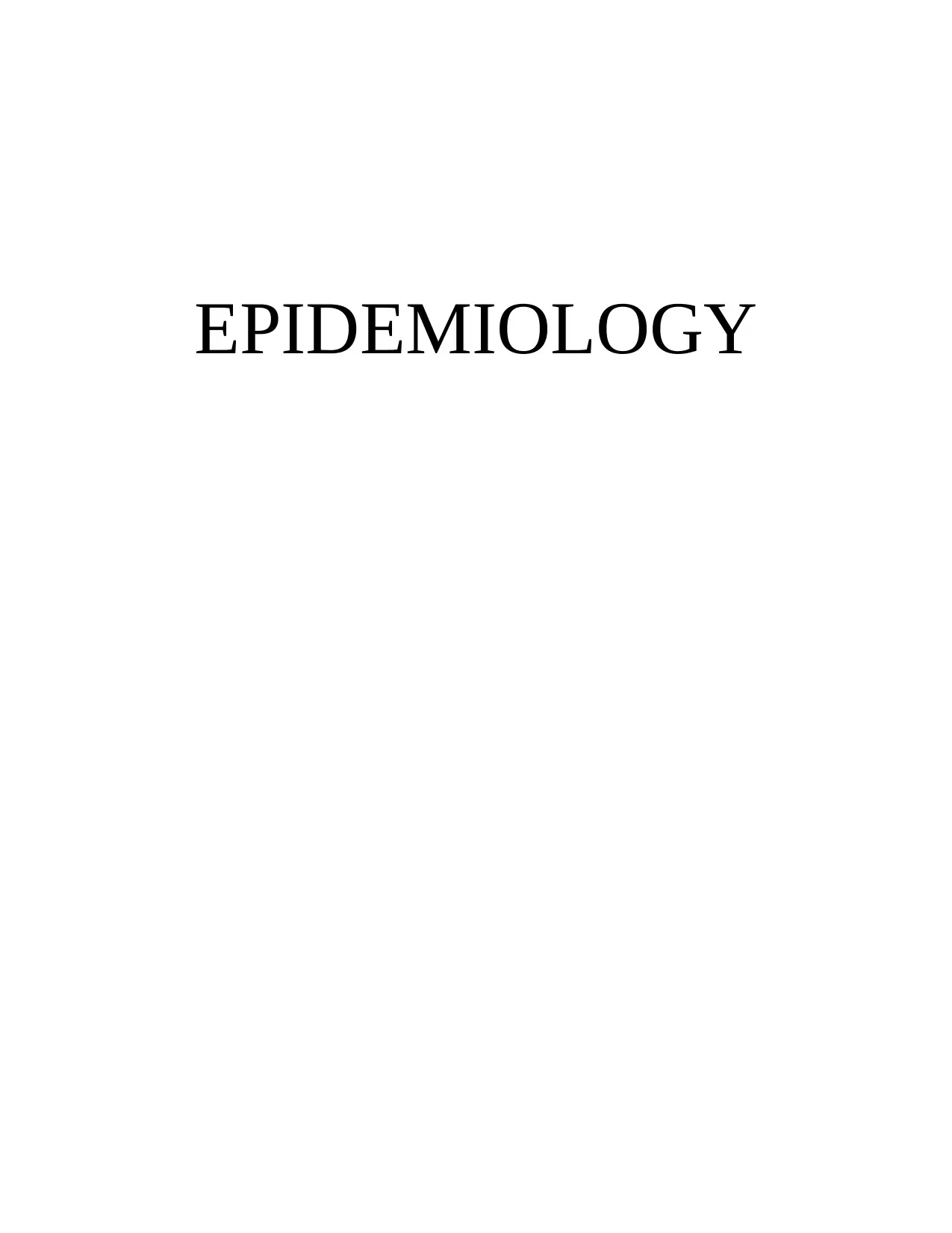
EPIDEMIOLOGY
Secure Best Marks with AI Grader
Need help grading? Try our AI Grader for instant feedback on your assignments.
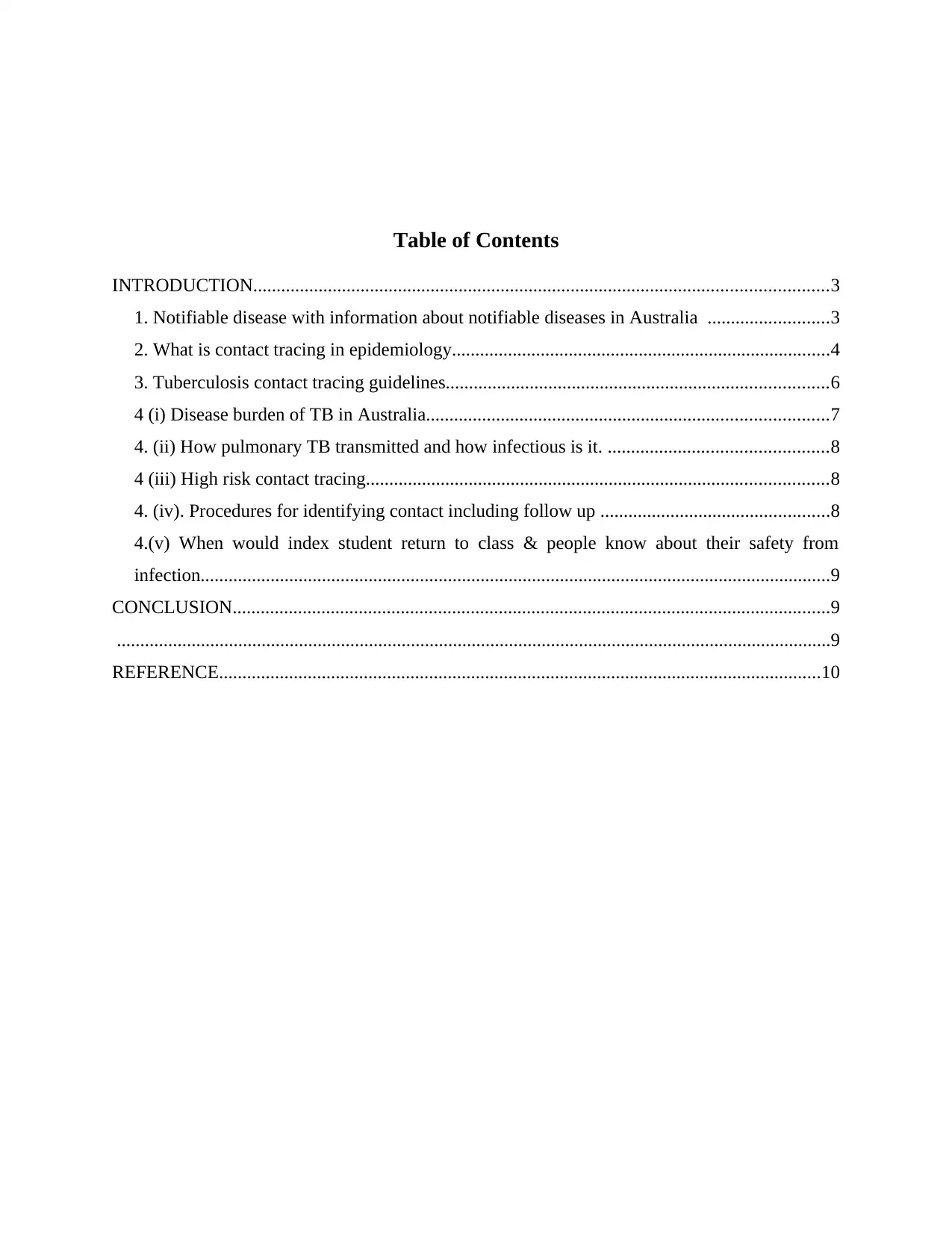
Table of Contents
INTRODUCTION...........................................................................................................................3
1. Notifiable disease with information about notifiable diseases in Australia ..........................3
2. What is contact tracing in epidemiology.................................................................................4
3. Tuberculosis contact tracing guidelines..................................................................................6
4 (i) Disease burden of TB in Australia......................................................................................7
4. (ii) How pulmonary TB transmitted and how infectious is it. ...............................................8
4 (iii) High risk contact tracing...................................................................................................8
4. (iv). Procedures for identifying contact including follow up .................................................8
4.(v) When would index student return to class & people know about their safety from
infection.......................................................................................................................................9
CONCLUSION................................................................................................................................9
.........................................................................................................................................................9
REFERENCE.................................................................................................................................10
INTRODUCTION...........................................................................................................................3
1. Notifiable disease with information about notifiable diseases in Australia ..........................3
2. What is contact tracing in epidemiology.................................................................................4
3. Tuberculosis contact tracing guidelines..................................................................................6
4 (i) Disease burden of TB in Australia......................................................................................7
4. (ii) How pulmonary TB transmitted and how infectious is it. ...............................................8
4 (iii) High risk contact tracing...................................................................................................8
4. (iv). Procedures for identifying contact including follow up .................................................8
4.(v) When would index student return to class & people know about their safety from
infection.......................................................................................................................................9
CONCLUSION................................................................................................................................9
.........................................................................................................................................................9
REFERENCE.................................................................................................................................10
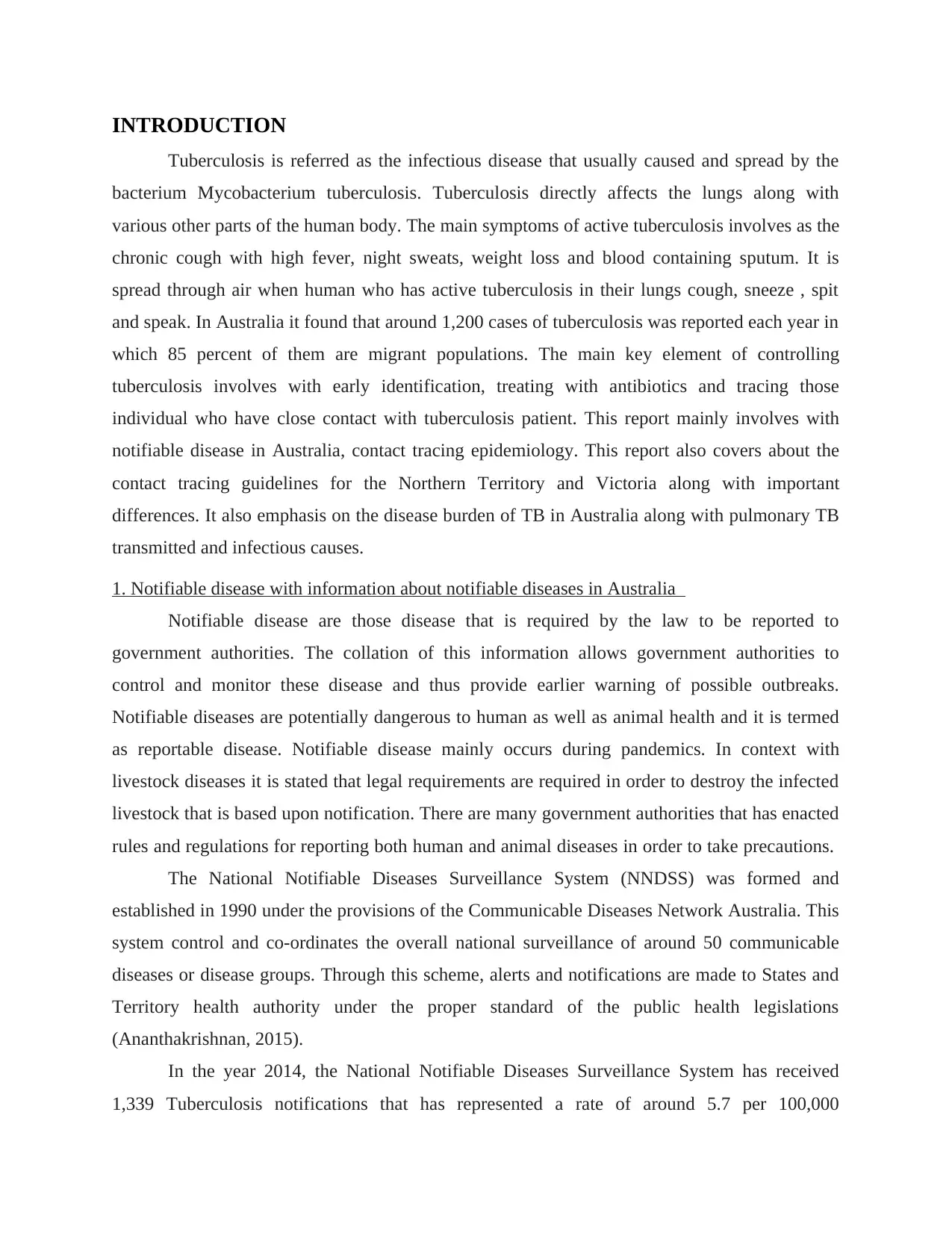
INTRODUCTION
Tuberculosis is referred as the infectious disease that usually caused and spread by the
bacterium Mycobacterium tuberculosis. Tuberculosis directly affects the lungs along with
various other parts of the human body. The main symptoms of active tuberculosis involves as the
chronic cough with high fever, night sweats, weight loss and blood containing sputum. It is
spread through air when human who has active tuberculosis in their lungs cough, sneeze , spit
and speak. In Australia it found that around 1,200 cases of tuberculosis was reported each year in
which 85 percent of them are migrant populations. The main key element of controlling
tuberculosis involves with early identification, treating with antibiotics and tracing those
individual who have close contact with tuberculosis patient. This report mainly involves with
notifiable disease in Australia, contact tracing epidemiology. This report also covers about the
contact tracing guidelines for the Northern Territory and Victoria along with important
differences. It also emphasis on the disease burden of TB in Australia along with pulmonary TB
transmitted and infectious causes.
1. Notifiable disease with information about notifiable diseases in Australia
Notifiable disease are those disease that is required by the law to be reported to
government authorities. The collation of this information allows government authorities to
control and monitor these disease and thus provide earlier warning of possible outbreaks.
Notifiable diseases are potentially dangerous to human as well as animal health and it is termed
as reportable disease. Notifiable disease mainly occurs during pandemics. In context with
livestock diseases it is stated that legal requirements are required in order to destroy the infected
livestock that is based upon notification. There are many government authorities that has enacted
rules and regulations for reporting both human and animal diseases in order to take precautions.
The National Notifiable Diseases Surveillance System (NNDSS) was formed and
established in 1990 under the provisions of the Communicable Diseases Network Australia. This
system control and co-ordinates the overall national surveillance of around 50 communicable
diseases or disease groups. Through this scheme, alerts and notifications are made to States and
Territory health authority under the proper standard of the public health legislations
(Ananthakrishnan, 2015).
In the year 2014, the National Notifiable Diseases Surveillance System has received
1,339 Tuberculosis notifications that has represented a rate of around 5.7 per 100,000
Tuberculosis is referred as the infectious disease that usually caused and spread by the
bacterium Mycobacterium tuberculosis. Tuberculosis directly affects the lungs along with
various other parts of the human body. The main symptoms of active tuberculosis involves as the
chronic cough with high fever, night sweats, weight loss and blood containing sputum. It is
spread through air when human who has active tuberculosis in their lungs cough, sneeze , spit
and speak. In Australia it found that around 1,200 cases of tuberculosis was reported each year in
which 85 percent of them are migrant populations. The main key element of controlling
tuberculosis involves with early identification, treating with antibiotics and tracing those
individual who have close contact with tuberculosis patient. This report mainly involves with
notifiable disease in Australia, contact tracing epidemiology. This report also covers about the
contact tracing guidelines for the Northern Territory and Victoria along with important
differences. It also emphasis on the disease burden of TB in Australia along with pulmonary TB
transmitted and infectious causes.
1. Notifiable disease with information about notifiable diseases in Australia
Notifiable disease are those disease that is required by the law to be reported to
government authorities. The collation of this information allows government authorities to
control and monitor these disease and thus provide earlier warning of possible outbreaks.
Notifiable diseases are potentially dangerous to human as well as animal health and it is termed
as reportable disease. Notifiable disease mainly occurs during pandemics. In context with
livestock diseases it is stated that legal requirements are required in order to destroy the infected
livestock that is based upon notification. There are many government authorities that has enacted
rules and regulations for reporting both human and animal diseases in order to take precautions.
The National Notifiable Diseases Surveillance System (NNDSS) was formed and
established in 1990 under the provisions of the Communicable Diseases Network Australia. This
system control and co-ordinates the overall national surveillance of around 50 communicable
diseases or disease groups. Through this scheme, alerts and notifications are made to States and
Territory health authority under the proper standard of the public health legislations
(Ananthakrishnan, 2015).
In the year 2014, the National Notifiable Diseases Surveillance System has received
1,339 Tuberculosis notifications that has represented a rate of around 5.7 per 100,000
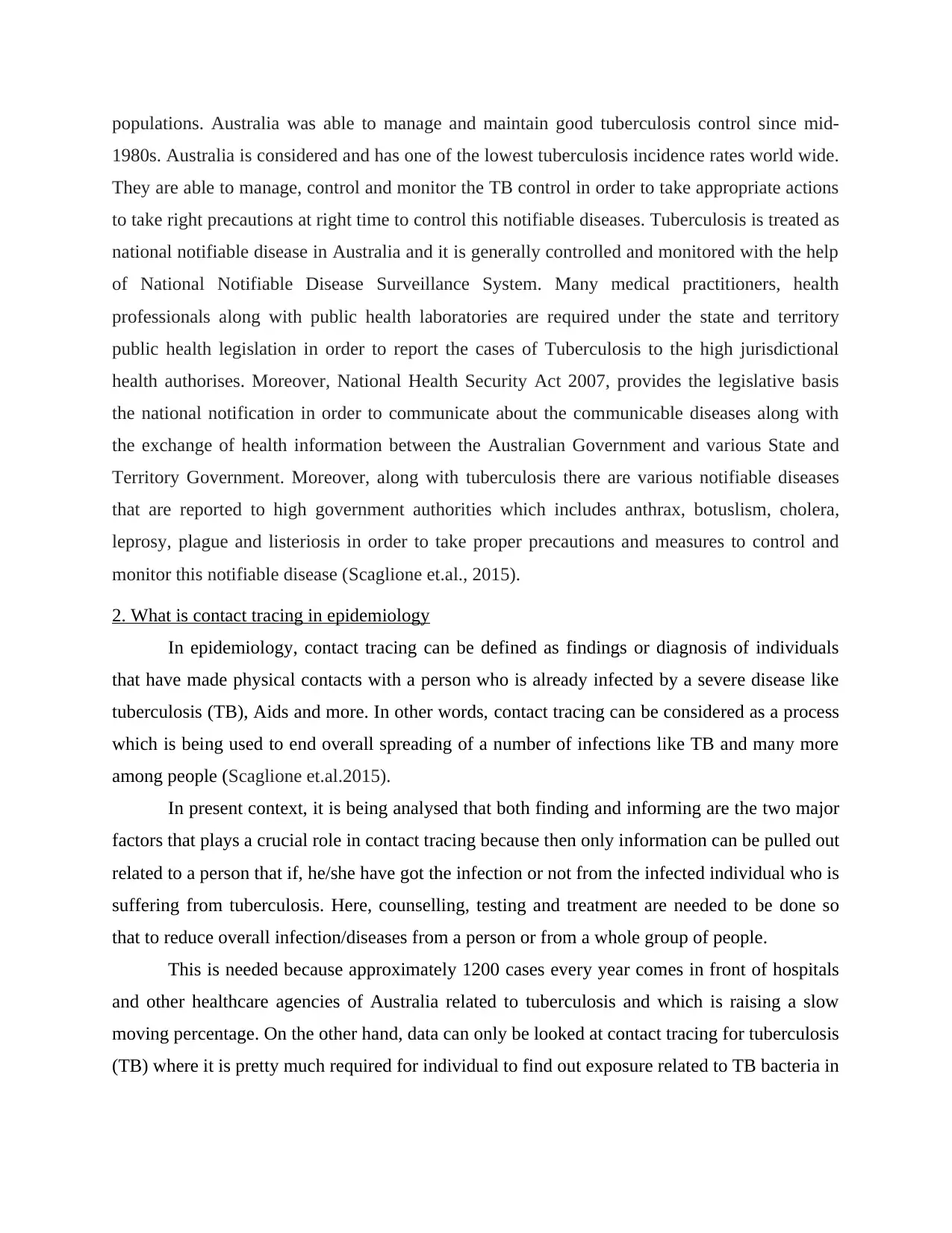
populations. Australia was able to manage and maintain good tuberculosis control since mid-
1980s. Australia is considered and has one of the lowest tuberculosis incidence rates world wide.
They are able to manage, control and monitor the TB control in order to take appropriate actions
to take right precautions at right time to control this notifiable diseases. Tuberculosis is treated as
national notifiable disease in Australia and it is generally controlled and monitored with the help
of National Notifiable Disease Surveillance System. Many medical practitioners, health
professionals along with public health laboratories are required under the state and territory
public health legislation in order to report the cases of Tuberculosis to the high jurisdictional
health authorises. Moreover, National Health Security Act 2007, provides the legislative basis
the national notification in order to communicate about the communicable diseases along with
the exchange of health information between the Australian Government and various State and
Territory Government. Moreover, along with tuberculosis there are various notifiable diseases
that are reported to high government authorities which includes anthrax, botuslism, cholera,
leprosy, plague and listeriosis in order to take proper precautions and measures to control and
monitor this notifiable disease (Scaglione et.al., 2015).
2. What is contact tracing in epidemiology
In epidemiology, contact tracing can be defined as findings or diagnosis of individuals
that have made physical contacts with a person who is already infected by a severe disease like
tuberculosis (TB), Aids and more. In other words, contact tracing can be considered as a process
which is being used to end overall spreading of a number of infections like TB and many more
among people (Scaglione et.al.2015).
In present context, it is being analysed that both finding and informing are the two major
factors that plays a crucial role in contact tracing because then only information can be pulled out
related to a person that if, he/she have got the infection or not from the infected individual who is
suffering from tuberculosis. Here, counselling, testing and treatment are needed to be done so
that to reduce overall infection/diseases from a person or from a whole group of people.
This is needed because approximately 1200 cases every year comes in front of hospitals
and other healthcare agencies of Australia related to tuberculosis and which is raising a slow
moving percentage. On the other hand, data can only be looked at contact tracing for tuberculosis
(TB) where it is pretty much required for individual to find out exposure related to TB bacteria in
1980s. Australia is considered and has one of the lowest tuberculosis incidence rates world wide.
They are able to manage, control and monitor the TB control in order to take appropriate actions
to take right precautions at right time to control this notifiable diseases. Tuberculosis is treated as
national notifiable disease in Australia and it is generally controlled and monitored with the help
of National Notifiable Disease Surveillance System. Many medical practitioners, health
professionals along with public health laboratories are required under the state and territory
public health legislation in order to report the cases of Tuberculosis to the high jurisdictional
health authorises. Moreover, National Health Security Act 2007, provides the legislative basis
the national notification in order to communicate about the communicable diseases along with
the exchange of health information between the Australian Government and various State and
Territory Government. Moreover, along with tuberculosis there are various notifiable diseases
that are reported to high government authorities which includes anthrax, botuslism, cholera,
leprosy, plague and listeriosis in order to take proper precautions and measures to control and
monitor this notifiable disease (Scaglione et.al., 2015).
2. What is contact tracing in epidemiology
In epidemiology, contact tracing can be defined as findings or diagnosis of individuals
that have made physical contacts with a person who is already infected by a severe disease like
tuberculosis (TB), Aids and more. In other words, contact tracing can be considered as a process
which is being used to end overall spreading of a number of infections like TB and many more
among people (Scaglione et.al.2015).
In present context, it is being analysed that both finding and informing are the two major
factors that plays a crucial role in contact tracing because then only information can be pulled out
related to a person that if, he/she have got the infection or not from the infected individual who is
suffering from tuberculosis. Here, counselling, testing and treatment are needed to be done so
that to reduce overall infection/diseases from a person or from a whole group of people.
This is needed because approximately 1200 cases every year comes in front of hospitals
and other healthcare agencies of Australia related to tuberculosis and which is raising a slow
moving percentage. On the other hand, data can only be looked at contact tracing for tuberculosis
(TB) where it is pretty much required for individual to find out exposure related to TB bacteria in
Secure Best Marks with AI Grader
Need help grading? Try our AI Grader for instant feedback on your assignments.
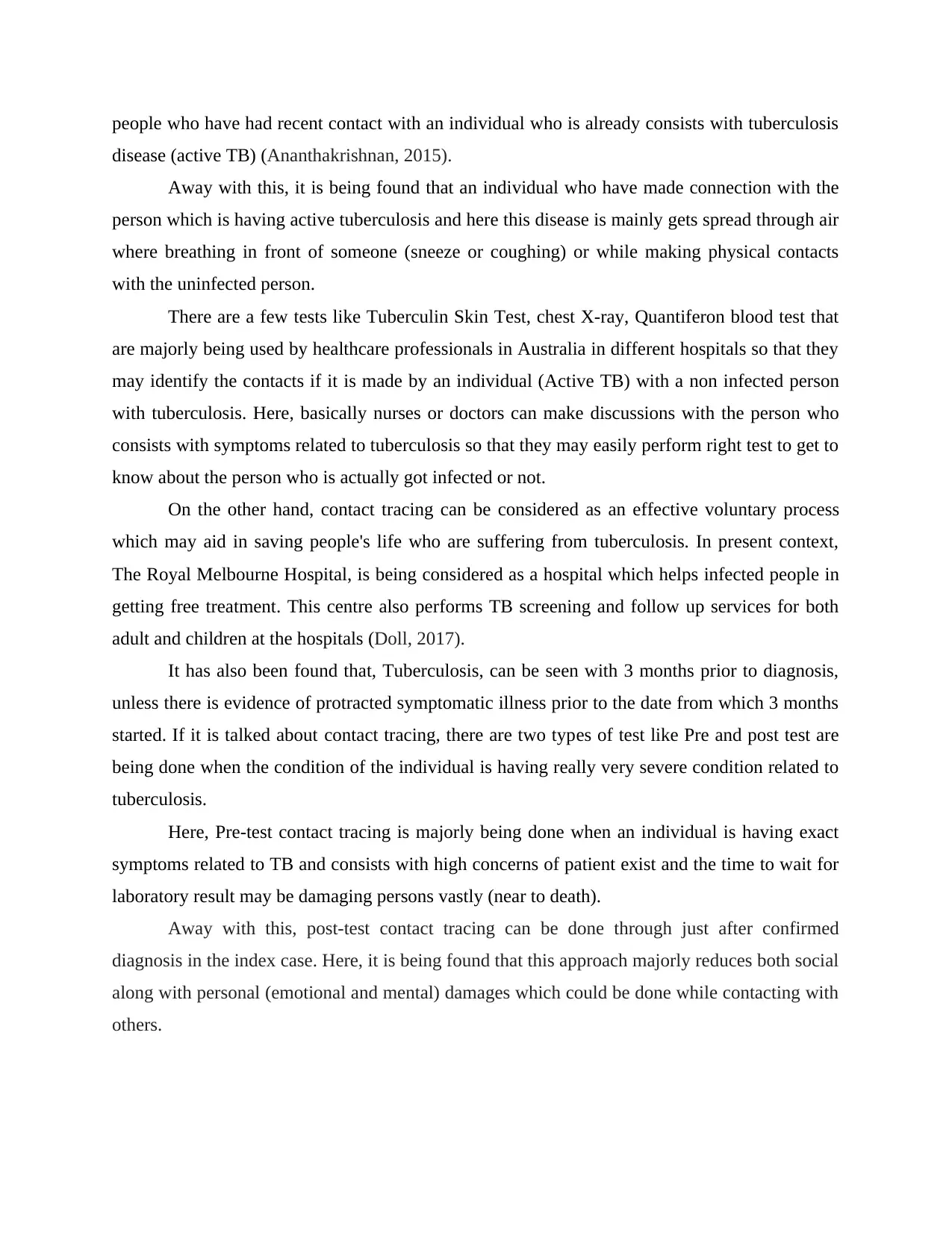
people who have had recent contact with an individual who is already consists with tuberculosis
disease (active TB) (Ananthakrishnan, 2015).
Away with this, it is being found that an individual who have made connection with the
person which is having active tuberculosis and here this disease is mainly gets spread through air
where breathing in front of someone (sneeze or coughing) or while making physical contacts
with the uninfected person.
There are a few tests like Tuberculin Skin Test, chest X-ray, Quantiferon blood test that
are majorly being used by healthcare professionals in Australia in different hospitals so that they
may identify the contacts if it is made by an individual (Active TB) with a non infected person
with tuberculosis. Here, basically nurses or doctors can make discussions with the person who
consists with symptoms related to tuberculosis so that they may easily perform right test to get to
know about the person who is actually got infected or not.
On the other hand, contact tracing can be considered as an effective voluntary process
which may aid in saving people's life who are suffering from tuberculosis. In present context,
The Royal Melbourne Hospital, is being considered as a hospital which helps infected people in
getting free treatment. This centre also performs TB screening and follow up services for both
adult and children at the hospitals (Doll, 2017).
It has also been found that, Tuberculosis, can be seen with 3 months prior to diagnosis,
unless there is evidence of protracted symptomatic illness prior to the date from which 3 months
started. If it is talked about contact tracing, there are two types of test like Pre and post test are
being done when the condition of the individual is having really very severe condition related to
tuberculosis.
Here, Pre-test contact tracing is majorly being done when an individual is having exact
symptoms related to TB and consists with high concerns of patient exist and the time to wait for
laboratory result may be damaging persons vastly (near to death).
Away with this, post-test contact tracing can be done through just after confirmed
diagnosis in the index case. Here, it is being found that this approach majorly reduces both social
along with personal (emotional and mental) damages which could be done while contacting with
others.
disease (active TB) (Ananthakrishnan, 2015).
Away with this, it is being found that an individual who have made connection with the
person which is having active tuberculosis and here this disease is mainly gets spread through air
where breathing in front of someone (sneeze or coughing) or while making physical contacts
with the uninfected person.
There are a few tests like Tuberculin Skin Test, chest X-ray, Quantiferon blood test that
are majorly being used by healthcare professionals in Australia in different hospitals so that they
may identify the contacts if it is made by an individual (Active TB) with a non infected person
with tuberculosis. Here, basically nurses or doctors can make discussions with the person who
consists with symptoms related to tuberculosis so that they may easily perform right test to get to
know about the person who is actually got infected or not.
On the other hand, contact tracing can be considered as an effective voluntary process
which may aid in saving people's life who are suffering from tuberculosis. In present context,
The Royal Melbourne Hospital, is being considered as a hospital which helps infected people in
getting free treatment. This centre also performs TB screening and follow up services for both
adult and children at the hospitals (Doll, 2017).
It has also been found that, Tuberculosis, can be seen with 3 months prior to diagnosis,
unless there is evidence of protracted symptomatic illness prior to the date from which 3 months
started. If it is talked about contact tracing, there are two types of test like Pre and post test are
being done when the condition of the individual is having really very severe condition related to
tuberculosis.
Here, Pre-test contact tracing is majorly being done when an individual is having exact
symptoms related to TB and consists with high concerns of patient exist and the time to wait for
laboratory result may be damaging persons vastly (near to death).
Away with this, post-test contact tracing can be done through just after confirmed
diagnosis in the index case. Here, it is being found that this approach majorly reduces both social
along with personal (emotional and mental) damages which could be done while contacting with
others.
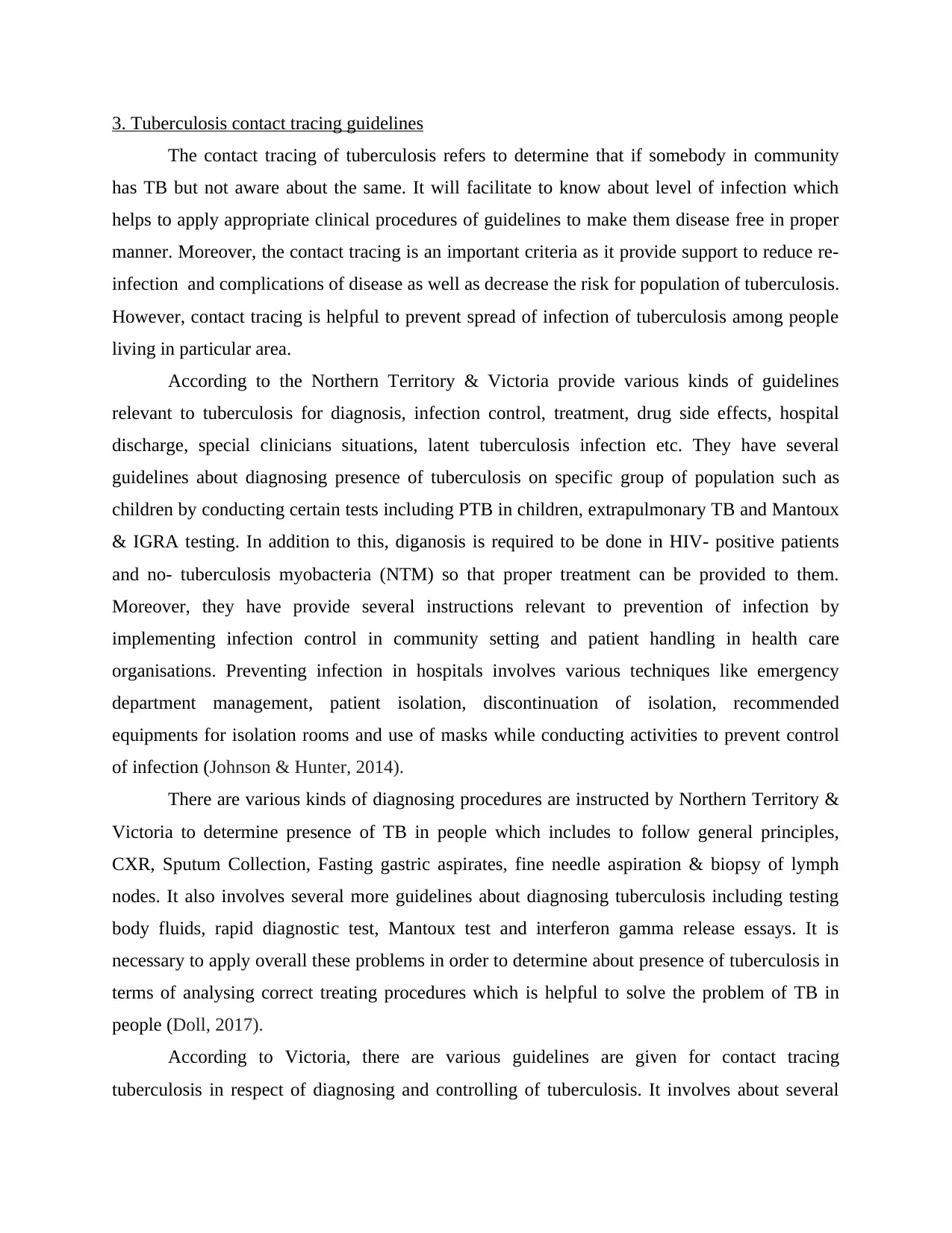
3. Tuberculosis contact tracing guidelines
The contact tracing of tuberculosis refers to determine that if somebody in community
has TB but not aware about the same. It will facilitate to know about level of infection which
helps to apply appropriate clinical procedures of guidelines to make them disease free in proper
manner. Moreover, the contact tracing is an important criteria as it provide support to reduce re-
infection and complications of disease as well as decrease the risk for population of tuberculosis.
However, contact tracing is helpful to prevent spread of infection of tuberculosis among people
living in particular area.
According to the Northern Territory & Victoria provide various kinds of guidelines
relevant to tuberculosis for diagnosis, infection control, treatment, drug side effects, hospital
discharge, special clinicians situations, latent tuberculosis infection etc. They have several
guidelines about diagnosing presence of tuberculosis on specific group of population such as
children by conducting certain tests including PTB in children, extrapulmonary TB and Mantoux
& IGRA testing. In addition to this, diganosis is required to be done in HIV- positive patients
and no- tuberculosis myobacteria (NTM) so that proper treatment can be provided to them.
Moreover, they have provide several instructions relevant to prevention of infection by
implementing infection control in community setting and patient handling in health care
organisations. Preventing infection in hospitals involves various techniques like emergency
department management, patient isolation, discontinuation of isolation, recommended
equipments for isolation rooms and use of masks while conducting activities to prevent control
of infection (Johnson & Hunter, 2014).
There are various kinds of diagnosing procedures are instructed by Northern Territory &
Victoria to determine presence of TB in people which includes to follow general principles,
CXR, Sputum Collection, Fasting gastric aspirates, fine needle aspiration & biopsy of lymph
nodes. It also involves several more guidelines about diagnosing tuberculosis including testing
body fluids, rapid diagnostic test, Mantoux test and interferon gamma release essays. It is
necessary to apply overall these problems in order to determine about presence of tuberculosis in
terms of analysing correct treating procedures which is helpful to solve the problem of TB in
people (Doll, 2017).
According to Victoria, there are various guidelines are given for contact tracing
tuberculosis in respect of diagnosing and controlling of tuberculosis. It involves about several
The contact tracing of tuberculosis refers to determine that if somebody in community
has TB but not aware about the same. It will facilitate to know about level of infection which
helps to apply appropriate clinical procedures of guidelines to make them disease free in proper
manner. Moreover, the contact tracing is an important criteria as it provide support to reduce re-
infection and complications of disease as well as decrease the risk for population of tuberculosis.
However, contact tracing is helpful to prevent spread of infection of tuberculosis among people
living in particular area.
According to the Northern Territory & Victoria provide various kinds of guidelines
relevant to tuberculosis for diagnosis, infection control, treatment, drug side effects, hospital
discharge, special clinicians situations, latent tuberculosis infection etc. They have several
guidelines about diagnosing presence of tuberculosis on specific group of population such as
children by conducting certain tests including PTB in children, extrapulmonary TB and Mantoux
& IGRA testing. In addition to this, diganosis is required to be done in HIV- positive patients
and no- tuberculosis myobacteria (NTM) so that proper treatment can be provided to them.
Moreover, they have provide several instructions relevant to prevention of infection by
implementing infection control in community setting and patient handling in health care
organisations. Preventing infection in hospitals involves various techniques like emergency
department management, patient isolation, discontinuation of isolation, recommended
equipments for isolation rooms and use of masks while conducting activities to prevent control
of infection (Johnson & Hunter, 2014).
There are various kinds of diagnosing procedures are instructed by Northern Territory &
Victoria to determine presence of TB in people which includes to follow general principles,
CXR, Sputum Collection, Fasting gastric aspirates, fine needle aspiration & biopsy of lymph
nodes. It also involves several more guidelines about diagnosing tuberculosis including testing
body fluids, rapid diagnostic test, Mantoux test and interferon gamma release essays. It is
necessary to apply overall these problems in order to determine about presence of tuberculosis in
terms of analysing correct treating procedures which is helpful to solve the problem of TB in
people (Doll, 2017).
According to Victoria, there are various guidelines are given for contact tracing
tuberculosis in respect of diagnosing and controlling of tuberculosis. It involves about several
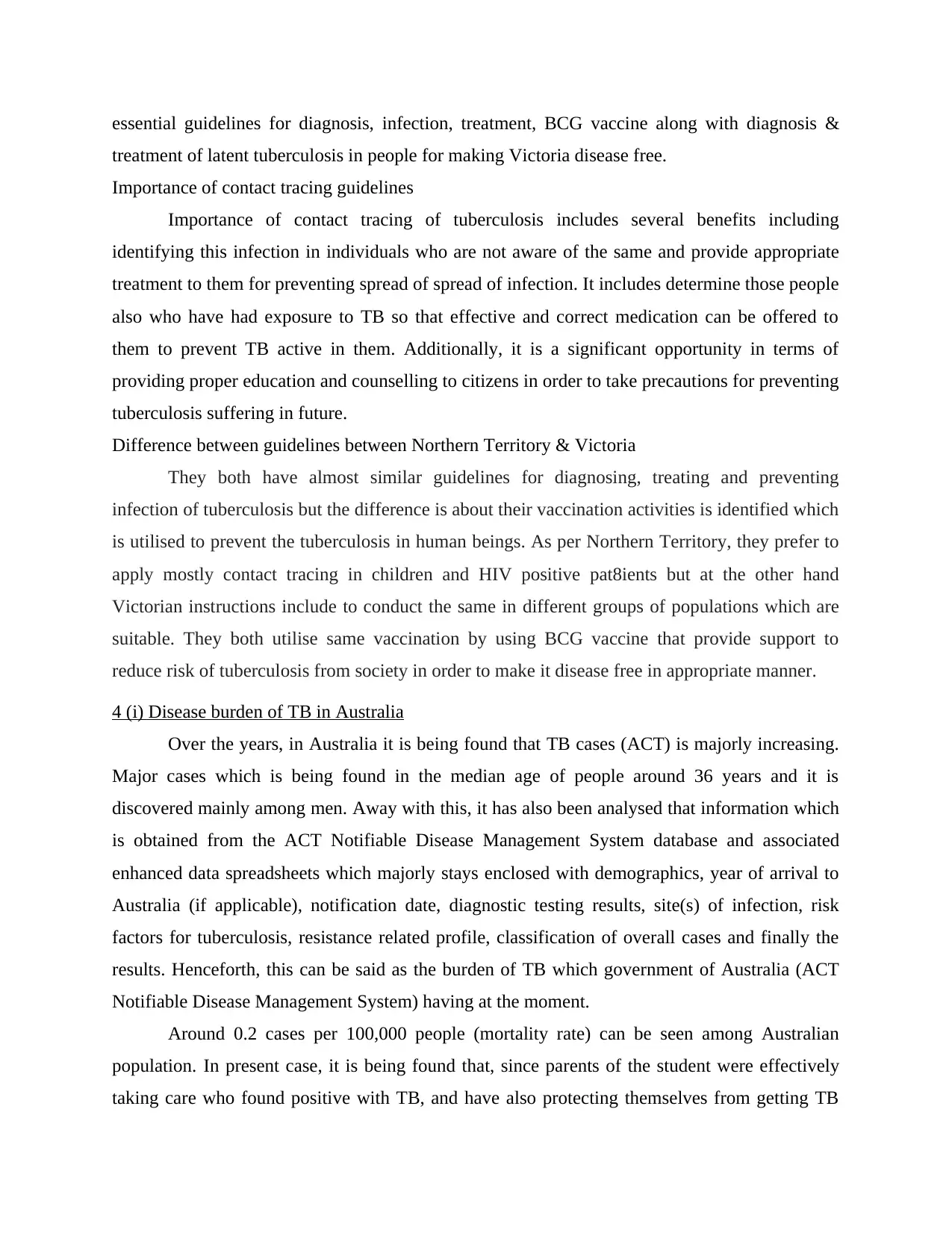
essential guidelines for diagnosis, infection, treatment, BCG vaccine along with diagnosis &
treatment of latent tuberculosis in people for making Victoria disease free.
Importance of contact tracing guidelines
Importance of contact tracing of tuberculosis includes several benefits including
identifying this infection in individuals who are not aware of the same and provide appropriate
treatment to them for preventing spread of spread of infection. It includes determine those people
also who have had exposure to TB so that effective and correct medication can be offered to
them to prevent TB active in them. Additionally, it is a significant opportunity in terms of
providing proper education and counselling to citizens in order to take precautions for preventing
tuberculosis suffering in future.
Difference between guidelines between Northern Territory & Victoria
They both have almost similar guidelines for diagnosing, treating and preventing
infection of tuberculosis but the difference is about their vaccination activities is identified which
is utilised to prevent the tuberculosis in human beings. As per Northern Territory, they prefer to
apply mostly contact tracing in children and HIV positive pat8ients but at the other hand
Victorian instructions include to conduct the same in different groups of populations which are
suitable. They both utilise same vaccination by using BCG vaccine that provide support to
reduce risk of tuberculosis from society in order to make it disease free in appropriate manner.
4 (i) Disease burden of TB in Australia
Over the years, in Australia it is being found that TB cases (ACT) is majorly increasing.
Major cases which is being found in the median age of people around 36 years and it is
discovered mainly among men. Away with this, it has also been analysed that information which
is obtained from the ACT Notifiable Disease Management System database and associated
enhanced data spreadsheets which majorly stays enclosed with demographics, year of arrival to
Australia (if applicable), notification date, diagnostic testing results, site(s) of infection, risk
factors for tuberculosis, resistance related profile, classification of overall cases and finally the
results. Henceforth, this can be said as the burden of TB which government of Australia (ACT
Notifiable Disease Management System) having at the moment.
Around 0.2 cases per 100,000 people (mortality rate) can be seen among Australian
population. In present case, it is being found that, since parents of the student were effectively
taking care who found positive with TB, and have also protecting themselves from getting TB
treatment of latent tuberculosis in people for making Victoria disease free.
Importance of contact tracing guidelines
Importance of contact tracing of tuberculosis includes several benefits including
identifying this infection in individuals who are not aware of the same and provide appropriate
treatment to them for preventing spread of spread of infection. It includes determine those people
also who have had exposure to TB so that effective and correct medication can be offered to
them to prevent TB active in them. Additionally, it is a significant opportunity in terms of
providing proper education and counselling to citizens in order to take precautions for preventing
tuberculosis suffering in future.
Difference between guidelines between Northern Territory & Victoria
They both have almost similar guidelines for diagnosing, treating and preventing
infection of tuberculosis but the difference is about their vaccination activities is identified which
is utilised to prevent the tuberculosis in human beings. As per Northern Territory, they prefer to
apply mostly contact tracing in children and HIV positive pat8ients but at the other hand
Victorian instructions include to conduct the same in different groups of populations which are
suitable. They both utilise same vaccination by using BCG vaccine that provide support to
reduce risk of tuberculosis from society in order to make it disease free in appropriate manner.
4 (i) Disease burden of TB in Australia
Over the years, in Australia it is being found that TB cases (ACT) is majorly increasing.
Major cases which is being found in the median age of people around 36 years and it is
discovered mainly among men. Away with this, it has also been analysed that information which
is obtained from the ACT Notifiable Disease Management System database and associated
enhanced data spreadsheets which majorly stays enclosed with demographics, year of arrival to
Australia (if applicable), notification date, diagnostic testing results, site(s) of infection, risk
factors for tuberculosis, resistance related profile, classification of overall cases and finally the
results. Henceforth, this can be said as the burden of TB which government of Australia (ACT
Notifiable Disease Management System) having at the moment.
Around 0.2 cases per 100,000 people (mortality rate) can be seen among Australian
population. In present case, it is being found that, since parents of the student were effectively
taking care who found positive with TB, and have also protecting themselves from getting TB
Paraphrase This Document
Need a fresh take? Get an instant paraphrase of this document with our AI Paraphraser
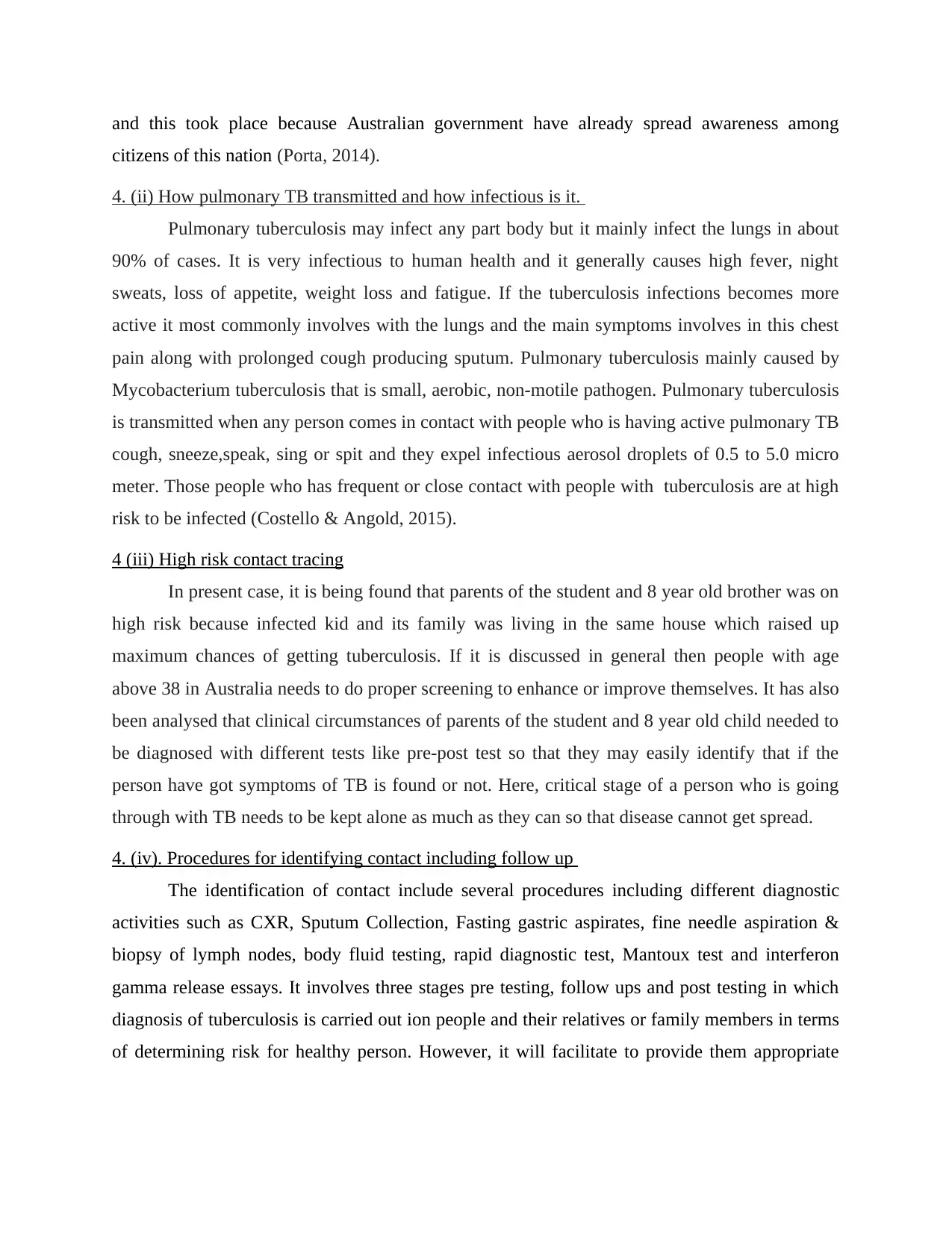
and this took place because Australian government have already spread awareness among
citizens of this nation (Porta, 2014).
4. (ii) How pulmonary TB transmitted and how infectious is it.
Pulmonary tuberculosis may infect any part body but it mainly infect the lungs in about
90% of cases. It is very infectious to human health and it generally causes high fever, night
sweats, loss of appetite, weight loss and fatigue. If the tuberculosis infections becomes more
active it most commonly involves with the lungs and the main symptoms involves in this chest
pain along with prolonged cough producing sputum. Pulmonary tuberculosis mainly caused by
Mycobacterium tuberculosis that is small, aerobic, non-motile pathogen. Pulmonary tuberculosis
is transmitted when any person comes in contact with people who is having active pulmonary TB
cough, sneeze,speak, sing or spit and they expel infectious aerosol droplets of 0.5 to 5.0 micro
meter. Those people who has frequent or close contact with people with tuberculosis are at high
risk to be infected (Costello & Angold, 2015).
4 (iii) High risk contact tracing
In present case, it is being found that parents of the student and 8 year old brother was on
high risk because infected kid and its family was living in the same house which raised up
maximum chances of getting tuberculosis. If it is discussed in general then people with age
above 38 in Australia needs to do proper screening to enhance or improve themselves. It has also
been analysed that clinical circumstances of parents of the student and 8 year old child needed to
be diagnosed with different tests like pre-post test so that they may easily identify that if the
person have got symptoms of TB is found or not. Here, critical stage of a person who is going
through with TB needs to be kept alone as much as they can so that disease cannot get spread.
4. (iv). Procedures for identifying contact including follow up
The identification of contact include several procedures including different diagnostic
activities such as CXR, Sputum Collection, Fasting gastric aspirates, fine needle aspiration &
biopsy of lymph nodes, body fluid testing, rapid diagnostic test, Mantoux test and interferon
gamma release essays. It involves three stages pre testing, follow ups and post testing in which
diagnosis of tuberculosis is carried out ion people and their relatives or family members in terms
of determining risk for healthy person. However, it will facilitate to provide them appropriate
citizens of this nation (Porta, 2014).
4. (ii) How pulmonary TB transmitted and how infectious is it.
Pulmonary tuberculosis may infect any part body but it mainly infect the lungs in about
90% of cases. It is very infectious to human health and it generally causes high fever, night
sweats, loss of appetite, weight loss and fatigue. If the tuberculosis infections becomes more
active it most commonly involves with the lungs and the main symptoms involves in this chest
pain along with prolonged cough producing sputum. Pulmonary tuberculosis mainly caused by
Mycobacterium tuberculosis that is small, aerobic, non-motile pathogen. Pulmonary tuberculosis
is transmitted when any person comes in contact with people who is having active pulmonary TB
cough, sneeze,speak, sing or spit and they expel infectious aerosol droplets of 0.5 to 5.0 micro
meter. Those people who has frequent or close contact with people with tuberculosis are at high
risk to be infected (Costello & Angold, 2015).
4 (iii) High risk contact tracing
In present case, it is being found that parents of the student and 8 year old brother was on
high risk because infected kid and its family was living in the same house which raised up
maximum chances of getting tuberculosis. If it is discussed in general then people with age
above 38 in Australia needs to do proper screening to enhance or improve themselves. It has also
been analysed that clinical circumstances of parents of the student and 8 year old child needed to
be diagnosed with different tests like pre-post test so that they may easily identify that if the
person have got symptoms of TB is found or not. Here, critical stage of a person who is going
through with TB needs to be kept alone as much as they can so that disease cannot get spread.
4. (iv). Procedures for identifying contact including follow up
The identification of contact include several procedures including different diagnostic
activities such as CXR, Sputum Collection, Fasting gastric aspirates, fine needle aspiration &
biopsy of lymph nodes, body fluid testing, rapid diagnostic test, Mantoux test and interferon
gamma release essays. It involves three stages pre testing, follow ups and post testing in which
diagnosis of tuberculosis is carried out ion people and their relatives or family members in terms
of determining risk for healthy person. However, it will facilitate to provide them appropriate
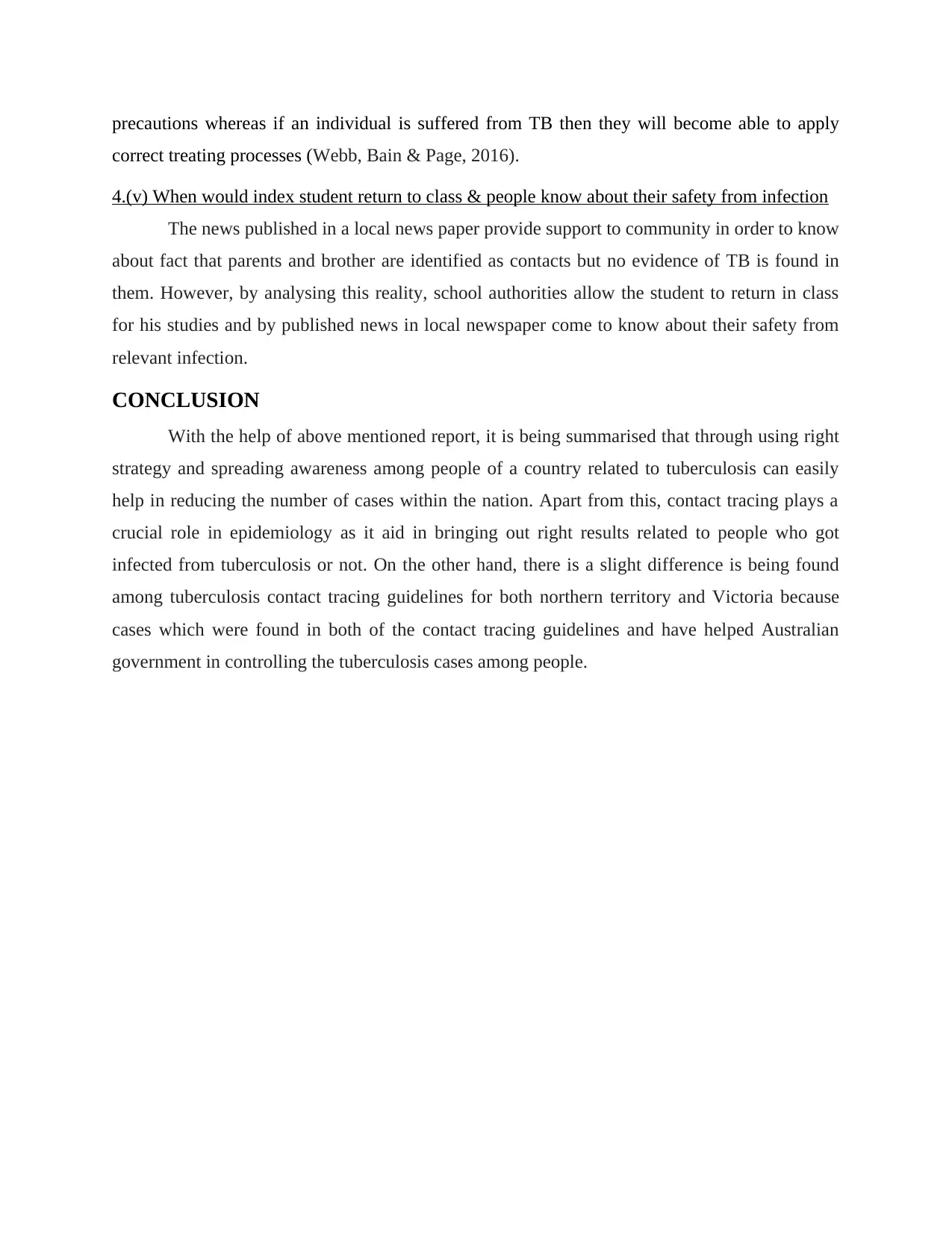
precautions whereas if an individual is suffered from TB then they will become able to apply
correct treating processes (Webb, Bain & Page, 2016).
4.(v) When would index student return to class & people know about their safety from infection
The news published in a local news paper provide support to community in order to know
about fact that parents and brother are identified as contacts but no evidence of TB is found in
them. However, by analysing this reality, school authorities allow the student to return in class
for his studies and by published news in local newspaper come to know about their safety from
relevant infection.
CONCLUSION
With the help of above mentioned report, it is being summarised that through using right
strategy and spreading awareness among people of a country related to tuberculosis can easily
help in reducing the number of cases within the nation. Apart from this, contact tracing plays a
crucial role in epidemiology as it aid in bringing out right results related to people who got
infected from tuberculosis or not. On the other hand, there is a slight difference is being found
among tuberculosis contact tracing guidelines for both northern territory and Victoria because
cases which were found in both of the contact tracing guidelines and have helped Australian
government in controlling the tuberculosis cases among people.
correct treating processes (Webb, Bain & Page, 2016).
4.(v) When would index student return to class & people know about their safety from infection
The news published in a local news paper provide support to community in order to know
about fact that parents and brother are identified as contacts but no evidence of TB is found in
them. However, by analysing this reality, school authorities allow the student to return in class
for his studies and by published news in local newspaper come to know about their safety from
relevant infection.
CONCLUSION
With the help of above mentioned report, it is being summarised that through using right
strategy and spreading awareness among people of a country related to tuberculosis can easily
help in reducing the number of cases within the nation. Apart from this, contact tracing plays a
crucial role in epidemiology as it aid in bringing out right results related to people who got
infected from tuberculosis or not. On the other hand, there is a slight difference is being found
among tuberculosis contact tracing guidelines for both northern territory and Victoria because
cases which were found in both of the contact tracing guidelines and have helped Australian
government in controlling the tuberculosis cases among people.
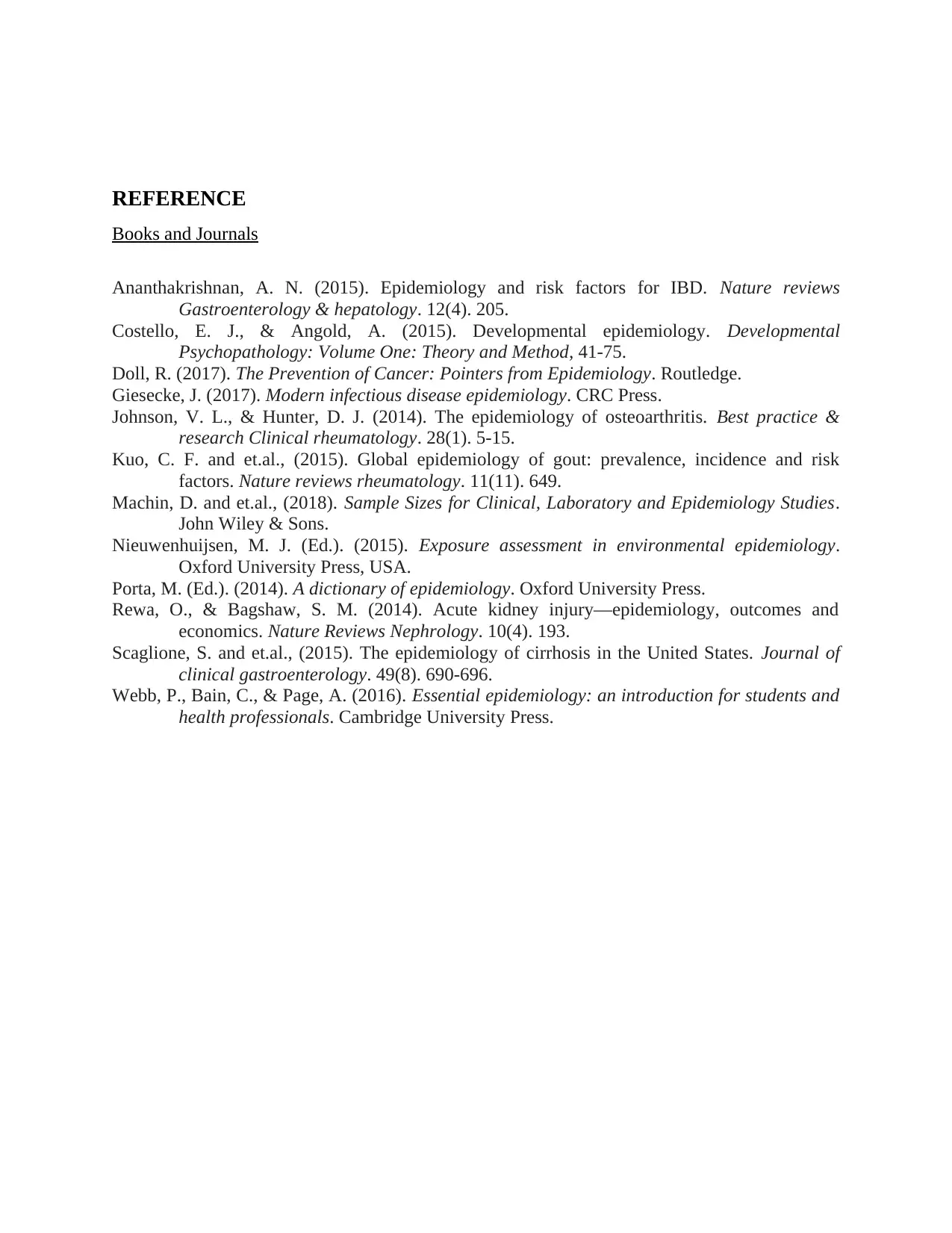
REFERENCE
Books and Journals
Ananthakrishnan, A. N. (2015). Epidemiology and risk factors for IBD. Nature reviews
Gastroenterology & hepatology. 12(4). 205.
Costello, E. J., & Angold, A. (2015). Developmental epidemiology. Developmental
Psychopathology: Volume One: Theory and Method, 41-75.
Doll, R. (2017). The Prevention of Cancer: Pointers from Epidemiology. Routledge.
Giesecke, J. (2017). Modern infectious disease epidemiology. CRC Press.
Johnson, V. L., & Hunter, D. J. (2014). The epidemiology of osteoarthritis. Best practice &
research Clinical rheumatology. 28(1). 5-15.
Kuo, C. F. and et.al., (2015). Global epidemiology of gout: prevalence, incidence and risk
factors. Nature reviews rheumatology. 11(11). 649.
Machin, D. and et.al., (2018). Sample Sizes for Clinical, Laboratory and Epidemiology Studies.
John Wiley & Sons.
Nieuwenhuijsen, M. J. (Ed.). (2015). Exposure assessment in environmental epidemiology.
Oxford University Press, USA.
Porta, M. (Ed.). (2014). A dictionary of epidemiology. Oxford University Press.
Rewa, O., & Bagshaw, S. M. (2014). Acute kidney injury—epidemiology, outcomes and
economics. Nature Reviews Nephrology. 10(4). 193.
Scaglione, S. and et.al., (2015). The epidemiology of cirrhosis in the United States. Journal of
clinical gastroenterology. 49(8). 690-696.
Webb, P., Bain, C., & Page, A. (2016). Essential epidemiology: an introduction for students and
health professionals. Cambridge University Press.
Books and Journals
Ananthakrishnan, A. N. (2015). Epidemiology and risk factors for IBD. Nature reviews
Gastroenterology & hepatology. 12(4). 205.
Costello, E. J., & Angold, A. (2015). Developmental epidemiology. Developmental
Psychopathology: Volume One: Theory and Method, 41-75.
Doll, R. (2017). The Prevention of Cancer: Pointers from Epidemiology. Routledge.
Giesecke, J. (2017). Modern infectious disease epidemiology. CRC Press.
Johnson, V. L., & Hunter, D. J. (2014). The epidemiology of osteoarthritis. Best practice &
research Clinical rheumatology. 28(1). 5-15.
Kuo, C. F. and et.al., (2015). Global epidemiology of gout: prevalence, incidence and risk
factors. Nature reviews rheumatology. 11(11). 649.
Machin, D. and et.al., (2018). Sample Sizes for Clinical, Laboratory and Epidemiology Studies.
John Wiley & Sons.
Nieuwenhuijsen, M. J. (Ed.). (2015). Exposure assessment in environmental epidemiology.
Oxford University Press, USA.
Porta, M. (Ed.). (2014). A dictionary of epidemiology. Oxford University Press.
Rewa, O., & Bagshaw, S. M. (2014). Acute kidney injury—epidemiology, outcomes and
economics. Nature Reviews Nephrology. 10(4). 193.
Scaglione, S. and et.al., (2015). The epidemiology of cirrhosis in the United States. Journal of
clinical gastroenterology. 49(8). 690-696.
Webb, P., Bain, C., & Page, A. (2016). Essential epidemiology: an introduction for students and
health professionals. Cambridge University Press.
1 out of 10
Related Documents
Your All-in-One AI-Powered Toolkit for Academic Success.
+13062052269
info@desklib.com
Available 24*7 on WhatsApp / Email
![[object Object]](/_next/static/media/star-bottom.7253800d.svg)
Unlock your academic potential
© 2024 | Zucol Services PVT LTD | All rights reserved.





